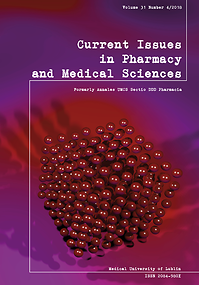Upper respiratory tract microbiota in health and disease – a minireview
DOI:
https://doi.org/10.1515/cipms-2018-0035Keywords:
respiratory microbiota, pathology, infectionsAbstract
A most common infection is that the upper respiratory tract. The human body is inhabited by millions of microorganisms, most of which enable the proper functioning of some systems and constitute a barrier protecting against harmful external factors. Due to the continuous contact of the upper airway microbiota with the external environment, it may seem to be extremely unstable and very diverse. A number of studies have been conducted that have assessed the effect of various factors on the composition of the upper respiratory tract microbiota. This paper presents a literature analysis which showed that the anatomical area is rich in terms of the microbiota that forms it, and despite the constant changes in many parameters, including physical – very stable.
References
1. Cui L et al. The Microbiome and the lung. Annals ATS. 2014;11: 227-32.
2. Ursell LK, Metcalf JL, Wegener Parfrey L, Knight R. Defining the human microbiome. Nutr Rev. 2012; 70 (Suppl 1): S38-S44.
3. Gorecka D, Nowinski A, Augustynowicz-Kopec E. Respiratory system microbiom (in polish). Pneumonol Alergol. 2014;82:481-5.
4. Malinowska M, Tokarz-Deptula B, Deptula W. Microbiome of the respiratory system under physiological and pathological conditions (in polish). Post Mikrobiol. 2016;55(3):279-83.
5. Andrzejczuk A, Chwiejczak E, Kosikowska U, Stepien-Pysniak D, Malm A. Phenotypic diveristy of Haemophilus influenza and Haemophilus parainfluenzae isolates depending on origin and health condition. Curr Issues Pharm Med Sci. 2017;30:90-9.
6. Kosikowska U, Rybojad P, Stepien-Pysniak D, Zbikowska A, Malm A. Changes in the prevalence and biofilm formation of Haemophilus influenzae and Haemophilus parainfluenzae from the respiratory microbiota of patients with sarcoidosis. BMC Infect Dis. 2016;16:499.
7. Allen KE, Koeppel AF, Hendley OJ, Turner SD, Winther B, Sale MM. Characterization of the nasopharyngeal microbiota in health and during rhinovirus challenge. Microbiome. 2014;2:22.
8. Bogaert D et al. Variability and diversity of nasopharyngeal microbiota in children: A metagenomic analysis. PLoS ONE. 2011;6
9. Chaban B, Albert A, Links MG, Gardy J, Tang P, Hill JE. Characterization of the upper respiratory tract microbiomes of patients with pandemic H1N1 influenza. PLoS ONE. 2013;8(7):69559
10. Chonmaitree T et al. Nasopharyngeal microbiota in infants and changes during viral upper respiratory tract infection and acute otitis media. PLoS ONE. 2017;12:0180630.
11. Chonmaitree T et al. Viral upper respiratory tract infection and otitis media complication in young children. Clin Inf Dis. 2008;46:815-823
12. Robinson J. Colonization and infection of the respiratory tract: What do we know? Paediatr Child Health. 2004;9:21-4.
13. Bosch A et al. Development of upper respiratory tract microbiota in infancy is affected by mode of delivery. EBioMed. 2016;9:336-45
14. Dominguez-Bello MG et al. Delivery mode shapes the acquisition and structure of the initial microbiota across multiple body habitats in newborns. PNAS. 2010;107:11971-5.
15. Cotton MF, Innes S, Jaspan H, Madide A, Rabie H. Management of upper respiratory tract infections in children. S Afr Fam Pract. 2008;50:6-12.
16. Thapa S, et al. Burden of bacterial upper respiratory tract pathogens in school children of Nepal. BMJ Open Resp Res. 2017;0:000203.
Downloads
Published
Issue
Section
License
Copyright (c) 2019 Autors

This work is licensed under a Creative Commons Attribution-NonCommercial-NoDerivatives 3.0 Unported License.


